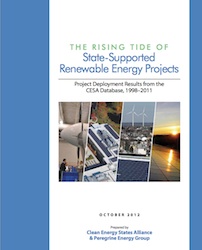This week Clean Energy States Alliance (CESA) has released a comprehensive analysis of state clean energy trends and development. “The Rising Tide of State-Supported Renewable Energy Projects: Results from the CESA Database, 1998-2011,” reports that state clean energy funds have been key major drivers of renewable energy development in the U.S. with nearly 130,000 projects and adding around 4.8 new gigwatts of clean energy to the grid.
 “Despite the economic climate, state clean energy funds have continued to demonstrate innovation, support emerging technologies, and advance clean energy markets,” said Mark Sinclair, executive eirector of CESA. “The better news is that, after 13 years of data collection, we feel confident that these industry trends are here to stay.”
“Despite the economic climate, state clean energy funds have continued to demonstrate innovation, support emerging technologies, and advance clean energy markets,” said Mark Sinclair, executive eirector of CESA. “The better news is that, after 13 years of data collection, we feel confident that these industry trends are here to stay.”
The report draws from the CESA National Renewable Energy Database, an ongoing effort to collect and maintain key metrics on investment in renewable energy projects in states that are members of CESA. Data collected includes things such as installed cost and funding leverage across projects and technologies and over time.
Key findings from this year’s CESA Database report include:
- 2011 saw the most state-funded clean energy projects installed in a single year with 32,734 clean energy projects, an 18 percent increase over 2010 and almost twice the number of projects installed in 2009.
- Since 1998, states have invested $3.4 billion in public funds in renewable energy projects and successfully leveraged an additional $12.5 billion. Total investment over this period was $15.9 billion.
Projects supported by state clean energy funds are avoiding significant CO2 emissions, and according to the report, each year, these projects generate almost 10.7 million megawatt hours of energy and avoid 8.1 million tons of CO2, the equivalent of taking about 1.4 million cars off the road. The report also features seven clean energy programs that CESA classified as a cut above the rest.

